The Samsung Galaxy S6 and S6 edge Review
by Joshua Ho on April 17, 2015 9:00 AM EST- Posted in
- Smartphones
- Samsung
- Mobile
- Galaxy S6
- Galaxy S6 Edge
NAND Performance: The First UFS Phone
Storage performance is often a critical area for user performance, as applications cannot be cached in RAM at every possible moment. Camera performance is also often limited by storage performance as RAM buffers can only do so much to maintain performance before it’s necessary to commit photos to non-volatile storage.
However due to the memory hierarchy to some extent, storage performance is often hard to notice once it’s at a point where things are “good enough”. Unfortunately, in some cases we can see OEMs failing to include sufficiently performant solid-state storage, which can be a major pain point in the user experience when random read/write performance is low enough that there are noticeable IO pauses as the system has to wait for data to be loaded from storage.
The Samsung Galaxy S6 family is the first shipping implementation of UFS (Universal Flash Storage) 2.0 standard, which makes the internal storage model less like an SD card in nature. When comparing the eMMC 5.1 standard to the UFS 2.0 standard, we see a move from a the 400 MB/s maximum of the eMMC 5.1 standard with HS400 physical link interface to MIPI M-PHY, which allows for a theoretical maximum of around 720 MB/s and should be more efficient in transmitting data than the current eMMC standard. In addition, UFS makes it possible to do full duplex communication, which means that reads and writes can happen simultaneously. There's also a command queue, which helps to avoid inefficiencies that could arise from waiting for commands once a command has been processed by the storage controller, and utilizes the SCSI protocol to facilitate these new features at the interface level.
As for the Galaxy S6 itself, the UFS implementation Samsung is using is Samsung developed. Samsung's current implementation only supports up to 300 MB/s (or 2.4 Gbps) transfer rates as a theoretical maximum, so from an interface perspective it's still not reaching the full capabilities of the standard. Though even at a cap of 300MB/sec, it still stands to be a significant improvement over typical eMMC solutions.
Finally, on a technical note, the 32GB models are of the model KLUBG4G1BD-E0B1 with a maximum queue depth of 16.
In order to test storage performance, we use Androbench with some custom settings to get a reasonable idea of performance in this area, although this test isn’t an exhaustive examination of storage performance by any means.
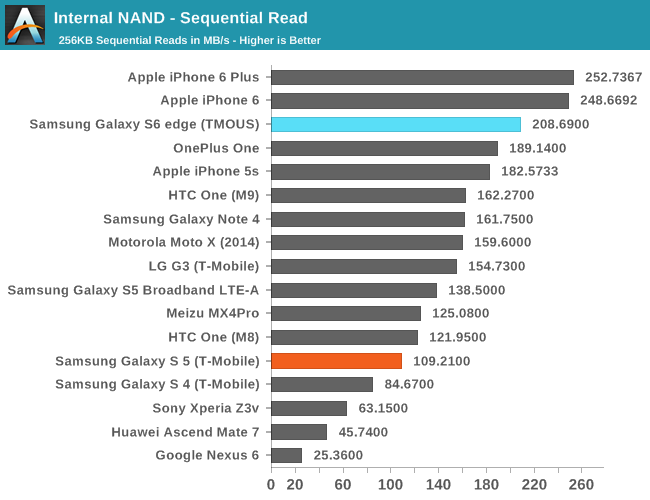
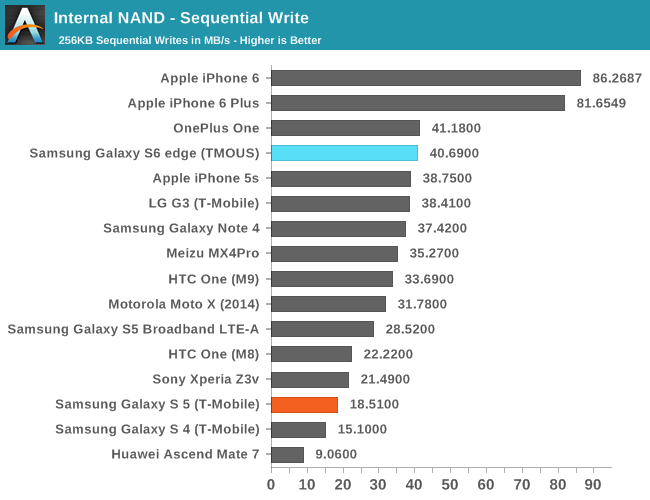
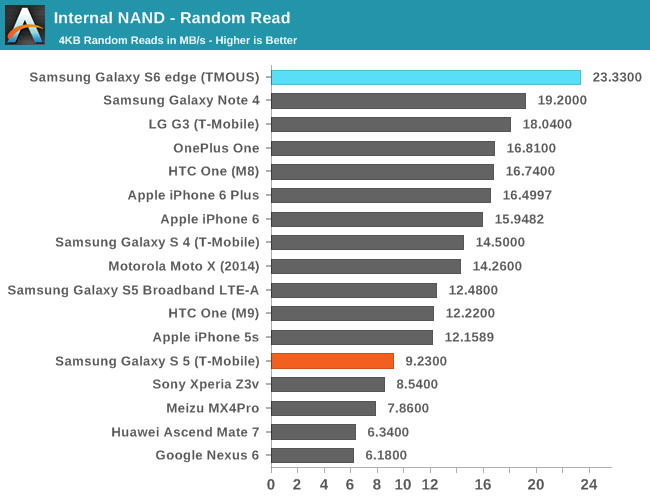
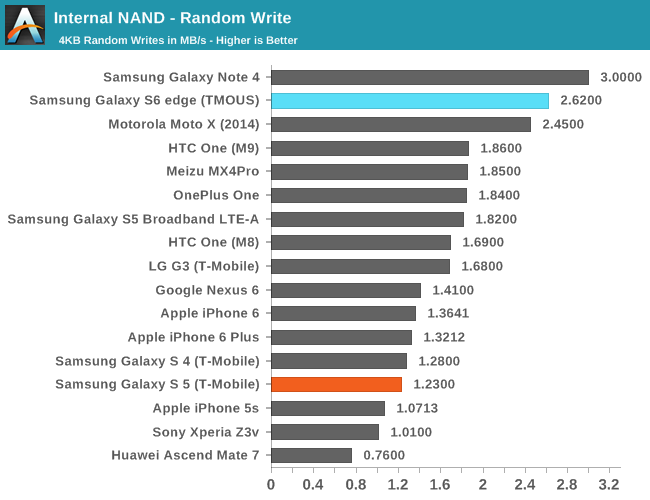
The Galaxy S6 performs rather impressively in our standard storage test, but not as fast as one might have hoped. This is due to the nature of the Androbench 3.6 test, which only tests a single IO thread, which won’t use the UFS storage of the Galaxy S6 to its full extent. In order to see the kind of difference that UFS really makes, I ran the same test again on Androbench 4.x, which does support multiple IO threads. However, as our iOS storage test and Androbench 3.6 don’t support more than a single IO thread we will continue to present both results for now.
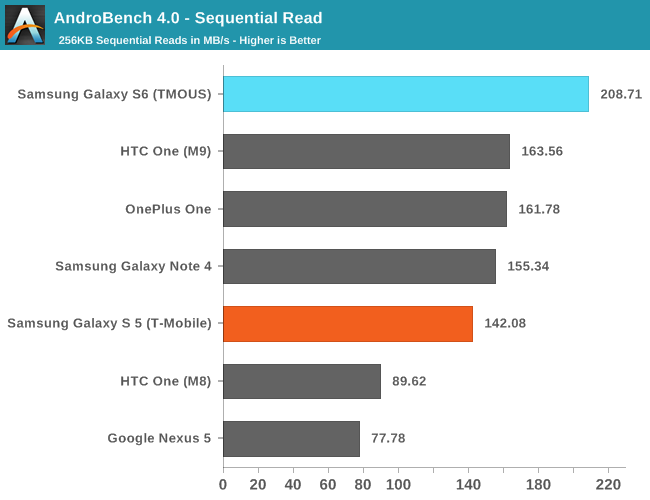
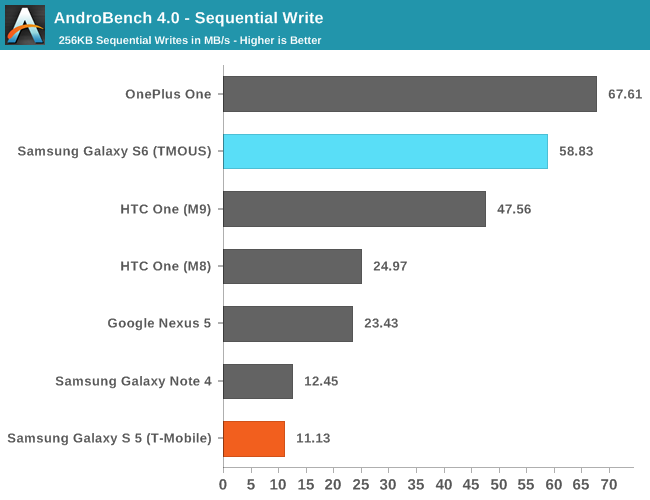
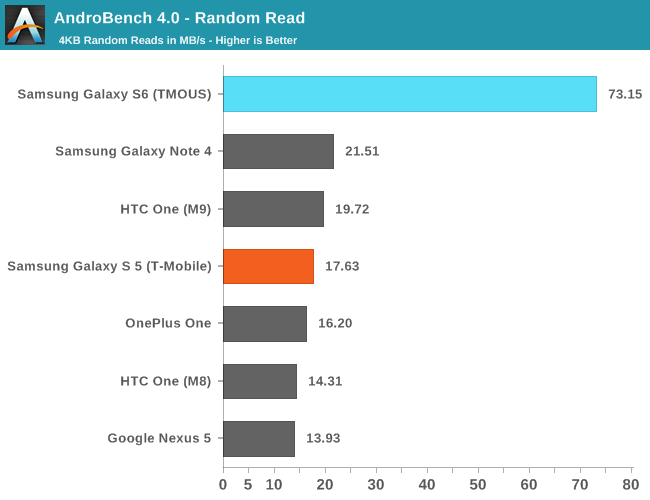
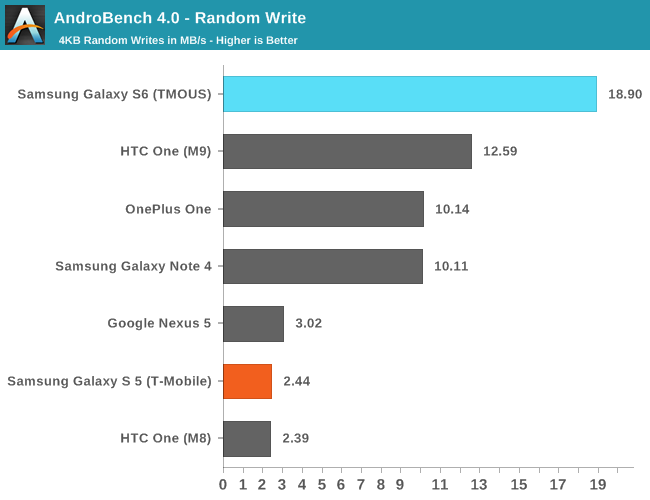
Overall, there are some immense benefits in storage performance here, especially in random IO performance. The Galaxy S6 has some of the fastest storage available in a phone today as far as I can tell given that this is basically a pure MLC solution, and shouldn’t have any real issue with storage performance holding back the rest of the phone over the course of 1-3 years as long as a reasonable amount of free space is kept to allow efficient storage management.


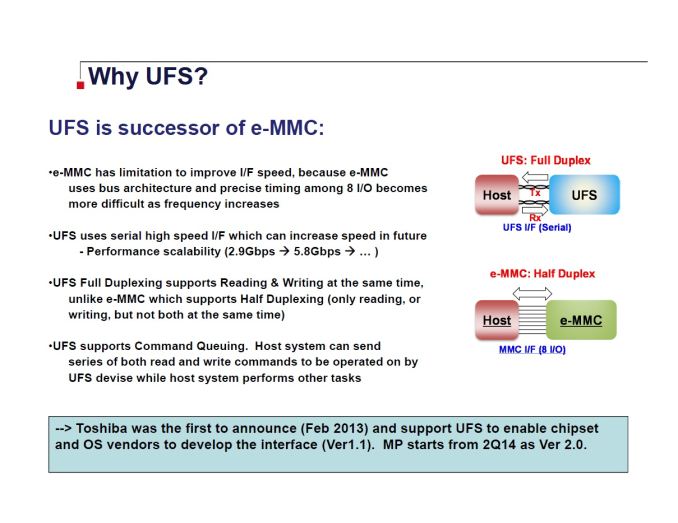








306 Comments
View All Comments
FlushedBubblyJock - Friday, April 24, 2015 - link
who are you kidding, yourselves ?YEARS AGO our big gov sucked all your data, and has been ever since
retroactive and completely illegal pardons were then issued
Frankly I'd rather he laws and the reality be that the idiot criminal government never be able to get anything, and the fact that they are sucking down everything all the time means I can't wait for it to stop
It's a principle, not a crime, sheep
They have no right to anything, EVER, that's what law abiding citizens DEMAND.
yvn - Friday, April 17, 2015 - link
I compared the edge to my iPhone 6 plus display and find still the display of the edge is still too saturated even in basic mode, how so...according to the benchmarks the display should be as good as the 6 plus but it was not, the color accuracy is still not as accurate??FlamingDragon810 - Friday, April 17, 2015 - link
Maybe because you're so used to the washed-out colors on your iPhone 6?The S6 has the most color-accurate display on the market. It's far better than the cheap IPS display on the iPhone 6.
yvn - Friday, April 17, 2015 - link
it is not true, my iPhone 6 plus display matches spot on with my calibrated iMac 27" screen via Spider 4 and Color Eyes Display Pro....so no Sir you are the one that is used to oversaturated colors on Samsung phones.....I am a full time photographer so I know a thing or two about accurate colorsFlamingDragon810 - Friday, April 17, 2015 - link
http://www.extremetech.com/mobile/200868-displayma...You're a full-time photographer who is used to washed-out colors from Apple.
Peichen - Saturday, April 18, 2015 - link
Ignore the troll. Both S6 and 6+ screen are accurate but S6 have lower white point than 6+. I am not sure about the color mode and adaptive color setting on the phone. I would suggest you wait for Erica Griffin's full review to come out on YouTube as she review color mode in detail. She only have hands-on review at the moment.generalako - Saturday, April 18, 2015 - link
You clearly don't know what the hell you are talking about. Read this review of the screen of the S6 by Displaymate (the only actual and legitimate display-tester out there): http://www.displaymate.com/Galaxy_S6_ShootOut_1.ht...The Galaxy S6 (like the Note 4) has by far the best display out there.
" The measured Absolute Color Error for the Galaxy S6 Basic Screen Mode is just 1.6 JNCD, tied with the Galaxy Note 4 as the most color accurate display that we have ever measured for a Smartphone or Tablet, which is visually indistinguishable from perfect, and is very likely considerably better than your living room TV or any display that you own.
assasinezio34 - Friday, April 17, 2015 - link
i have sold my s6 after 7 painful day.i really loved this phone.camera,screen exc..but battery life drove me crazy.returned to my iphone6 plus.Margalus - Friday, April 17, 2015 - link
I have never owned an apple product, and thought I never would. But after my experiences with the s4 and the android os things might be different next time. I still don't like apple and don't really want an iphone. I am a very light user, it's mostly for phone calls. What good is a phone that on it's best day will last about 16 hours. Then on other days with occasional bugs that cause the OS to go crazy and use the battery up in 4-5 hours with no usage..UrQuan3 - Friday, April 17, 2015 - link
Overall excellent review. I still really appreciate the screen color and gamut testing. It sets Anandtech apart. What equipment are you looking for to do audio testing? In my case, I am more interested in the headphone output than the speakers as I can't use the speakers in public anyway.